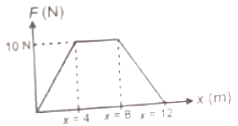Work done by frictional force
1. is always negative
2. is always positive
3. is zero
4. May be positive, negative or zero
Two bodies of masses m1 and m2 have same kinetic energy. The ratio of their momentum is
1.
2.
3.
4.
Two bodies of masses m1 and m2 have same momentum. The ratio of their KE is
1.
2.
3.
4.
Two bodies of masses m1 and m2 are moving with same kinetic energy. If P1 and P2 are their respective momentum, the ratio is equal to
1.
2.
3.
4.
A particle moves along X-axis from x=0 to x=1 m under the influence of a force given by . Work done in the process is
1. +4 J
2. -4 J
3. +8 J
4. -8 J
Under the action of a force, a 2 kg body moves such that its position x as a function of time t is given by , where x is in metre and t in second. The work done by the force in first two seconds is
1. 1600 J
2. 160 J
3. 16 J
4. J
KE acquired by a mass m intravelling a certain distance d, starting from rest, under the action of a constant force F is
1. Directly proportional to
2. Directly proportional to m
3. Directly proportional to
4. None of these
The total work done on a particle is equal to the change in its kinetic energy. This is applicable
1. Always
2. Only if the conservative forces are acting on it
3. Only in inertial frames
4. Only when pseudo forces are absent
A particle of mass 0.1 kg is subjected to a force which varies with distance as shown. If it starts its journey from rest at x=0, then its velocity at x=12 m is

1. 0 m/s
2. m/s
3. m/s
4. 40 m/s
Potential energy is defined:
| 1. | Only in conservative fields |
| 2. | As the negative of the work done by conservative forces |
| 3. | As the negative of the work done by external forces when \(\Delta K=0\) |
| 4. | All of these |






